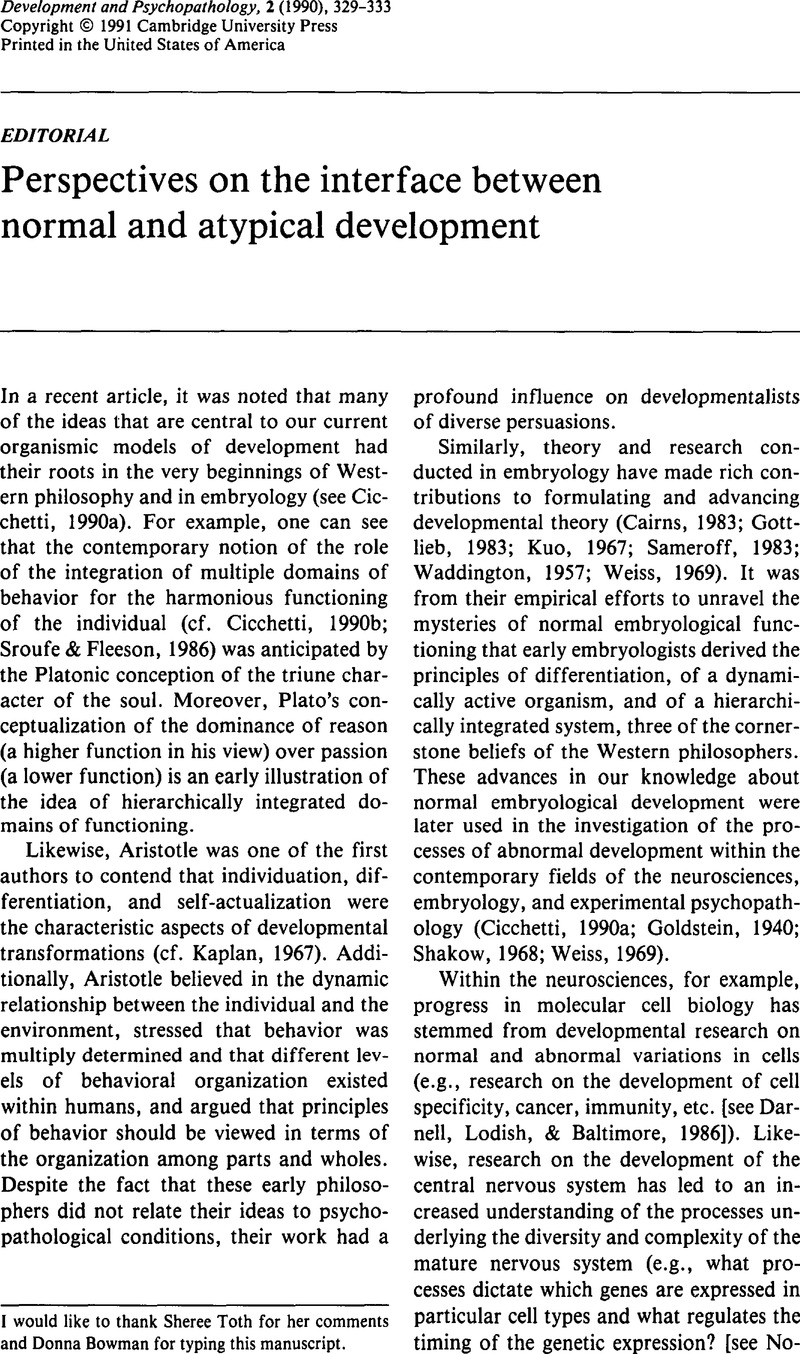Crossref Citations
This article has been cited by the following publications. This list is generated based on data provided by Crossref.
Phillips, Wendy
Baron-Cohen, Simon
and
Rutter, Michael
1992.
The role of eye contact in goal detection: Evidence from normal infants and children with autism or mental handicap.
Development and Psychopathology,
Vol. 4,
Issue. 3,
p.
375.
Rogosch, Fred A.
Mowbray, Carol T.
and
Bogat, G. Anne
1992.
Determinants of parenting attitudes in mothers with severe psychopathology.
Development and Psychopathology,
Vol. 4,
Issue. 3,
p.
469.
Richers, John E.
and
Cicchetti, Dante
1993.
Mark Twain meets DSM-III-R: Conduct disorder, development, and the concept of harmful dysfunction.
Development and Psychopathology,
Vol. 5,
Issue. 1-2,
p.
5.
Patrick, Matthew
Hobson, R. Peter
Castle, David
Howard, Robert
and
Maughan, Barbara
1994.
Personality disorder and the mental representation of early social experience.
Development and Psychopathology,
Vol. 6,
Issue. 2,
p.
375.
Anderson, Carolyn A.
Hinshaw, Stephen P.
and
Simmel, Cassandra
1994.
Mother-child interactions in ADHD and comparison boys: Relationships with overt and covert externalizing behavior.
Journal of Abnormal Child Psychology,
Vol. 22,
Issue. 2,
p.
247.
Buka, Stephen L.
and
Lipsitt, Lewis P.
1994.
Developmental Follow-up.
p.
331.
Jaedicke, Susan
Storoschuk, Sharon
and
Lord, Catherine
1994.
Subjective experience and causes of affect in high-functioning children and adolescents with autism.
Development and Psychopathology,
Vol. 6,
Issue. 2,
p.
273.
Hinshaw, Stephen P.
and
Melnick, Sharon M.
1995.
Peer relationships in boys with attention-deficit hyperactivity disorder with and without comorbid aggression.
Development and Psychopathology,
Vol. 7,
Issue. 4,
p.
627.
RICHTERS, JOHN E.
1996.
Disordered Views of Aggressive Children: A Late Twentieth Century Perspectivea.
Annals of the New York Academy of Sciences,
Vol. 794,
Issue. 1,
p.
208.
Hinshaw, Stephen P.
Zupan, Brian A.
Simmel, Cassandra
Nigg, Joel T.
and
Melnick, Sharon
1997.
Peer Status in Boys with and without Attention-Deficit Hyperactivity Disorder: Predictions from Overt and Covert Antisocial Behavior, Social Isolation, and Authoritative Parenting Beliefs.
Child Development,
Vol. 68,
Issue. 5,
p.
880.
Finegan, Jo-Anne
1998.
Study of behavioral phenotypes: Goals and methodological considerations.
American Journal of Medical Genetics,
Vol. 81,
Issue. 2,
p.
148.
Wills, Thomas Ashby
and
Dishion, Thomas J.
2004.
Temperament and Adolescent Substance Use: A Transactional Analysis of Emerging Self-Control.
Journal of Clinical Child & Adolescent Psychology,
Vol. 33,
Issue. 1,
p.
69.
Yates, Tuppett M
2004.
The developmental psychopathology of self-injurious behavior: Compensatory regulation in posttraumatic adaptation.
Clinical Psychology Review,
Vol. 24,
Issue. 1,
p.
35.
Rodriguez, Monica L.
Ayduk, Ozlem
Aber, J. Lawrence
Mischel, Walter
Sethi, Anita
and
Shoda, Yuichi
2005.
A Contextual Approach to the Development of Self‐regulatory Competencies: The Role of Maternal Unresponsivity and Toddlers’ Negative Affect in Stressful Situations.
Social Development,
Vol. 14,
Issue. 1,
p.
136.
Rettew, David C.
and
McKee, Laura
2005.
Temperament and Its Role in Developmental Psychopathology.
Harvard Review of Psychiatry,
Vol. 13,
Issue. 1,
p.
14.
Yates, Tuppett M.
Obradović, Jelena
and
Egeland, Byron
2010.
Transactional relations across contextual strain, parenting quality, and early childhood regulation and adaptation in a high-risk sample.
Development and Psychopathology,
Vol. 22,
Issue. 3,
p.
539.
2011.
Minnesota Symposia on Child Psychology.
p.
231.
Oades-Sese, Geraldine V.
Kitzie, Mark
Velderman, Christopher
Rubic, Wai-Ling
Rutstein, Sarah
and
Waltuck, Miles
2013.
Resilience in Children, Adolescents, and Adults.
p.
279.
Skala, Katrin
and
Bruckner, Thomas
2014.
Beating the odds: an approach to the topic of resilience in children and adolescents.
neuropsychiatrie,
Vol. 28,
Issue. 4,
p.
208.
Dishion, Thomas J.
Mun, Chung Jung
Drake, Emily C.
Tein, Jenn-Yun
Shaw, Daniel S.
and
Wilson, Melvin
2015.
A transactional approach to preventing early childhood neglect: The Family Check-Up as a public health strategy.
Development and Psychopathology,
Vol. 27,
Issue. 4pt2,
p.
1647.





